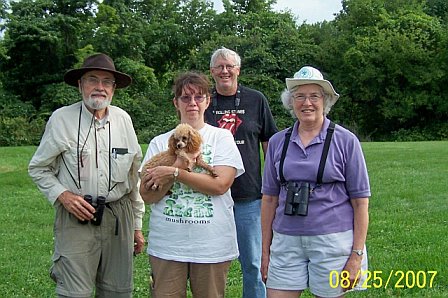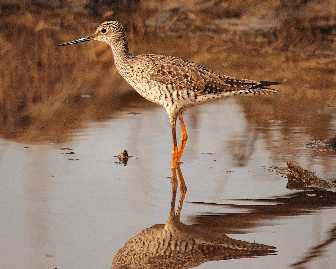


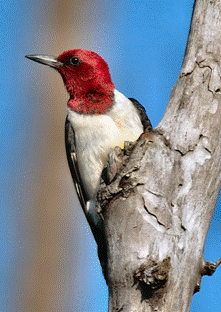
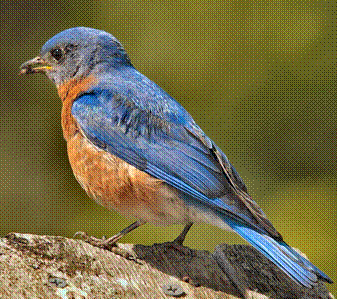
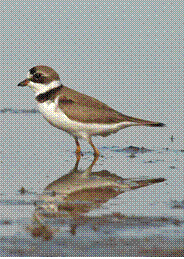

Rose by Harriet Alger, other photos by John Koscinski
EDITORS: JACK SMITH / HARRY SPENCER. PHOTOGRAPHER: JOHN KOSCINSKI
|
October 2007 Program Misadventures
and Mayhem: 30 Years of Birding Jim McCarty, Plain Dealer Jim McCarty is a columnist for the Cleveland Plain Dealer for which he covers several areas. He has been a birder for over 30 years and is well known to local birders for his column Aerial View, which appears every Thursday in the Plain Dealer. Field
Trip Saturday, October 6, 8:30 AM Hike to Wetlands Board
Meeting Tuesday, September 25, 6:30 PM Oberlin Depot Young Birders
Hike Oak Openings
Field Trip May 26, 2007 By Joann Wagner
In spite of overcast skies and some drizzle on the Ohio Turnpike,
sixteen Black River Audubon members enjoyed another enlightening
visit to Oak Openings and its Oak Savannah restoration. Immediately upon arrival, we noticed much
tree cutting. My first thought was about Emerald Ash Borer
infestation, but the trees were White Pines, cut because the species
is not indigenous in the original
ecosystem. This year's guide, Bob Jacksy, directed us to
an ancient glacial-beach ridge. The prevailing winds move the ridge
eastward about 50-100 feet per year. The ridge has reached a high
line of trees, east of which is a drop-off and low marsh area. It
will be interesting to follow the progression in the next 10-15
years. In a large, sandy, open field with sparse
growth: a few scattered shrubs and small trees, we spotted Ovenbird,
Carolina Wren, Tree Swallow, Eastern Kingbird, Indigo Bunting,
American Goldfinch, Eastern Wood-Pewee, Chipping Sparrow, Field
Sparrow, and exciting views of colorful Lark
Sparrows. In the taller perimeter trees we saw Tufted
Titmouse, Black-capped Chickadee, Northern Cardinal, Eastern Towhee,
Eastern Bluebird, Baltimore Oriole, Blue Jay, Brown-headed Cowbird,
Summer Tanager, American Kestrel, Northern Flicker, and House
Sparrow. Next we traveled east and north towards the
area where Blue Grosbeaks had been reported. On our way we
identified Hooded Warbler, Great-crested Flycatcher, Wood Thrush,
White-breasted Nuthatch, and American Robin, as well as European
Starling, House Finch, Mallard, Mute Swan, Great Egret, Great Blue
Heron, Chimney Swift, Killdeer, and Red-shouldered
Hawk. At the proper sighting area, we set up scopes
and immediately saw in the distance a robin-sized dark blue bird. We
debated between Indigo Bunting and Blue Grosbeak, but ruled for the
Grosbeak because of size and distance. We scoped from 2 sides of the
square field but the bird was at the furthest corner. Indigo
Buntings are by far the most prevalent nester in the
Park. Bob showed us lovely Yellow Lady Slippers, Gaywing, Wild Geranium, Mountain Phlox, Bladder Campion, Dwarf Dandelion, Dewberry, Plains Puccoon, Frostweed Serviceberry (Helianthemum canadense), and the fascinating Earth Star mushrooms. The rains and our hike ended and we took "the
back roads" homewardthrough White House and into
Bacon Woods
Summer Tureen Saturday, August 11, 2007 By Joann Wagner Six Black River Audubon members enjoyed a
warm but pleasant morning walk observing birds, plants, mushrooms,
and butterflies. Bird species identified included Red-bellied
Woodpecker, Downy Woodpecker, Pileated Woodpecker; Northern Flicker,
Eastern Bluebird, Acadian Flycatcher, Indigo Bunting, American
Goldfinch, Turkey Vulture, White-breasted Nuthatch, Gray Catbird,
Tufted Titmouse, Chipping Sparrow, Field Sparrow, Song Sparrow,
House Sparrow; a mob of American Crows, Red-eyed Vireo, and other
expected summer birds.
We observed Summer Azure, Tiger-swallowtail, White-cabbage,
Cloudless Sulphur, and many Silver-spotted Skipper
butterflies.
To top off the event, we enjoyed a refreshing lunch of fresh
Italian tomatoes, tossed salad, portions of a sub sandwich, deviled
eggs, and doughnuts.
Indian Hollow Tureen photo by Larry Morton Indian Hollow Summer Tureen Saturday, August 25, 2007 By Jenny Austin
After waiting fifteen minutes past the scheduled 9 AM starting time,
Ken and Jenny Austin, with their small dog, Sissy, set out on a
short hike through the woods. Sissy soon became excited about a
flock of domestic geese, but Ken and Jenny persuaded her to move on.
They saw cardinals and goldfinches and heard a Red-eyed Vireo back
in the woods. The abundant fungi covering the forest floor excited
Ken. Undoubtedly the previous week's hot and steamy days had
encouraged the growth of the fungi with their striking color. Ken and Sissy wanted to
investigate all the fungi.
Jenny swears that on the way back across the bridge, Sissy
communicated with a small friend going towards the woods. Sissy told
him what to look for and cautioned him to be careful and not eat the
fungi because they might give him a
bellyache.
Upon arrival at their car, the hikers met Larry and Sophia
Morton, who arrived shortly after the
After breakfast the group retraced the trail. They spotted
Cedar Waxwings, American Goldfinches, Northern Cardinals, Great Blue
Herons, White-breasted Nuthatches, Gray Catbirds, and, on the top a
tree, an Eastern Kingbird surveying his
kingdom. GOALS AND OBJECTIVES FOR
2007-8 By President Harriet Alger The following projects and
activities have been approved by the Black River Audubon Board for
2007-8: * Conduct monthly meetings with programs featuring topics and speakers on birds, relationships with other wildlife, and the importance of environmental conservation. *
Publish a monthly newsletter,
Wingtips, from September through May,
continuing the innovations of last year, i.e. color photos on the
covers and expanded coverage, which
have resulted in increased reader interest and
response. *
Continue initiatives to attract and keep new members. This
year letters with greetings and information were sent to all new
members, both National Audubon and local. BR members served as
greeters at monthly meetings and special efforts were made to help
new birders with bird ID on our monthly field
trips. *
Sponsor monthly weekend field trips to Important Bird Areas
in North Central and *
Continue monitoring our Bluebird Trail. We have added 66
nesting boxes this year with 4 new volunteer monitors and now
maintain and monitor about 250 boxes in 15 locations with 15
volunteers. *
Members will continue to record observations of birds in
local IBA’s on our BRAS e-bird site (eBird sponsored by Audubon and
Cornell). This local information is being used to chart the
observations and eventually identify local birding hot spots for a
Lorain County Birding Trail. *
Co-sponsor programs again this year with Lorain County Metro
Parks, featuring outstanding speakers who will attract not only
current birding enthusiasts but be of interest to the general
public. Last year’s
speakers included Bill Thompson, III, David Kline, Amish farmer and
birder, and Kim and Kenn
Kaufman. *
Continue to furnish Audubon Adventures kits to
3rd-6th grade classrooms and home schooling
families. The number of kits, 45, donated to educational settings
last year was more than twice the number of kits donated the year
before and we hope to add more this
year. *
Establish a Young Birders’ Club, as a local
affiliate to the Ohio YBC, for 12-18 year olds. Initial field trip for this
age group on June 9 was very successful. Monthly field trips will
begin in September 2007 in cooperation with Lorain County Metro
Parks’ naturalists. We will also offer one field trip a season
during 2007-8 for a Young Birders’ group of 8-11 year
olds. *
Initiate special birding hikes at *
Continue to maintain two conservation and education projects
established in cooperation with Lorain County Community College on
the College campus: (1) a Meadow Preserve for nesting Bobolinks,
Savannah Sparrows Eastern Meadowlarks, and Bluebird boxes and (2)
a Nature Interpretive
Trail with numbered markers for trees, plants and flowers, and
handouts available at each end of the trail for
identification. *
Continue the second year of a 5 year campaign in
coordination with National Audubon and Audubon *
Continue a series of bird hikes during the week in some of
the local Metro Parks and active birding sites in the * Continue to develop a long range plan to refine and establish goals ands objectives for the future. Summary: Proposed Budget
2007-8 By President Harriet Alger (Dollars) Estimated
Income
Bank balance (July 1, 2007)
10,509
Dedicated funds
6,520
Unrestricted funds
10,421
Total 2007-8
27,450 Estimated
Expenses
Dedicated categories
6,225
General expenses
12,200
Discretionary fund
9,025
Total 2007-8
27,450 By Jannah Tucker,
Naturalist, As a naturalist, I have always looked for
opportunities to expand my knowledge base in every facet of nature
identification. Birds
have been a particular interest of mine, but I have found it a
difficult area to study and to interpret to park visitors. So when the opportunity
arose for a scholarship to Upon arriving at My favorite excursion during the week was to
Eastern Egg Rock Island to see the puffins and other sea birds. The puffins were incredible,
and it was even more incredible to learn about how their populations
have been restored to that area over the past thirty years. I also saw several other sea
birds for the first time including Gannets, Laughing Gulls, and
guillemots. Thank you Black River Audubon Society for
giving me this scholarship.
I could not have asked for a better learning environment than
what was present at the camp.
With more bird knowledge and birding skills, I now feel more
comfortable to lead bird programs through the Metro Parks, and I
have birding programs scheduled for this
fall. Overall, I learned and experienced so much
that is difficult to narrow down what impacted me the most. However, one great bit of
advice that I received is quite simple. During one session Kenn
Kaufman said, “Don’t let bird identification get you down, bird
watching is really about enjoyment.” Hopefully through my
programs I will also be able to convey this very important message
that bird watching is fun! (Editors' note: The Black
River Audubon Society maintains a Scholarship Trust Fund whose value
on June 30, 2007 was almost $32,000. Capital gains are reinvested,
and the dividends support the cost of one week
at the Audubon Hog Island Camp in By Harry Spencer During the last few years, I have enjoyed
birding regularly along many of the Carlisle Reservation trails. My
constant companion, Star, my Cairn Terrier, and I hike almost daily.
She started accompanying me as a puppy and has continued in that
role ever since. Birding in one general area on a more or less
regular schedule offers many rewards. Walking regularly is
simultaneously healthy and enjoyable. An attentive regular walker
along a woodland or field trail observes both expected and
unexpected sights, sounds, and
aromas. Where are the various habitats along the
trail? Which birds frequent a particular habitat? In any particular
area, are the observed birds and their numbers similar to those of
last year? Where are
the Yellow Warbler's favorite areas? Where are the Orchard and
Baltimore Orioles nesting? Are the Hooded Warblers back? Did the
early cutting of the fields last year discourage the return of the
Bobolinks? Are the Coopers Hawks returning to the same nesting
areas? Did the spring storm that blew down the dead elm also
discourage the Ruby-throated Hummingbirds from perching in that area
during the summer? These are some of the questions that I asked
myself about A side benefit is meeting non-birders who
regularly hike the trails. At Within the general area covered by the Black
River Audubon Society are several birding hot spots in need of
regular monitors. Bacon Woods is one of the best birding areas, yet
no one regularly both observes the birds and records his or her
observations on our eBird site. Wellington Reservation is a new area
that has proven to be a true hot spot, but it is not regularly
monitored, at least by anyone recording identifications on our eBird
site. A third example is Birders of all degrees of skill -- from
complete beginner to expert -- can profit and enjoy birding
regularly. An expert only needs directions about how to record
observations. A beginner may want considerable guidance. If so, we
can provide it and suggest a plan for learning birding skills. And
one of the best ways of learning birding is to accompany an
experienced birder. We can arrange such cooperation. The only
qualification is a desire to learn and enjoy birding. If you are
interested in regular birding, such as monitoring a particular area
once a week, or even once a month, please contact me at 440 775-2929
or meshes@verizon.net.
WINGTIPS NOW on
the WEB! WINGTIPS is now online, available through a link at our home page, www.blackriveraudubon.org. Just click on WINGTIPS NEWSLETTER.
The WINGTIP
editors thank Scott Spencer of By Carol
Leininger U Uropygial
gland
Daily care of feathers is essential for birds. The feathers
become brittle without application of waxy secretions from the
uropygial gland (preen gland). The gland is located on the rump at
the base of the tail. Its secretion is an oil that is rich in waxes,
fatty acids, fat, and water. The bird applies this secretion with
its bill. On the feathers the oil cleans, preserves moistness, and
maintains flexibility. Regular applications sustain the oil's
insulating and
waterproofing functions. Certain
preen-gland lipids protect feathers against fungi and discourage
feather lice. The foul smelling preen-gland secretions of some
species may repel mammalian
predators. Diligent preening helps the birds' flying ability, and to avoid danger, birds must be always ready to fly. Yellowlegs Tringa melanoleuca and Tringa
flavipes By
Jack
Smith
Pictured below are photos of a Greater Yellowlegs and a
Lesser Yellowlegs. These birds, traditionally called shore birds,
are noted for their brilliant yellow legs (rarely orange). These two species are
closely related and look very much alike except that the Greater
Yellowlegs is 25 to 30% larger than the Lesser Yellowlegs. When both are present in a
mud flat the difference is obvious, but when observed alone, they
can be difficult for the inexperienced to tell apart. The veteran bird watcher,
however, focuses on the length of the bill relative to the length of
the head. The bill of
the Greater Yellowlegs is slightly up-turned and is about 1.5 times
the length of the head. In contrast, the bill of the Lesser
Yellowlegs is only slightly longer than the length of its
head. The ornithologists who
discovered the species gave them the scientific genus name of
Tringa, which is derived from the Greek work, Trynagas, used
by Aristotle to describe a white rumped bird. The assigned species name of
the Greater Yellowlegs,
melanoleuca is derived from Greek words melas and
leucas, which mean black and white. The assigned scientific
species name of the Lesser Yellowlegs is flavipes, derived from Latin flavus for yellow and pes for
foot. In flight, the birds display white rumps and
some black and white as well as brown and white speckles. Besides brilliant yellow
legs, both species have long wings, extending beyond the tails of
birds not flying. Greater Yellowlegs are larger than Lesser
Yellowlegs (12.5 to 15 inches versus 9.5 to 11 inches in length; 2
to 2.5 inches versus 1 to 1.5 inches bill length; 23 to 26 inches
versus 19.5 to 21.5 inches wing
spread). The sexes are similar in appearance, although
the female may be slightly larger. But the personalities of the
two species are different. Lesser Yellowlegs are more gregarious,
are seen in larger flocks, and are more tolerant of humans. The bill
of the Greater Yellowlegs may look slightly
upturned. The calls of the two species are distinctive.
That of the Greater Yellowlegs is a loud clear whistle,
“few-few-few” which often is an alarm call. Much to the annoyance of a
bird watcher trying to identify other birds, this alarm call spooks
other shore birds into flight.
The Lesser Yellowlegs' call notes are shorter, perhaps one or
two cu, cu. The call of the Greater Yellowlegs is much louder and
longer in duration. Only during migration do we see both species
in our area and then in shallow marshes and mudflats along the
shores of lakes and ponds.
The Greater Yellowlegs often calls attention to itself by
bobbing its head and calling loudly when approached by a bird
watcher. It is
interesting to watch both species as they forage by swinging their
heads back and forth with the bill in the water. Both species eat insects,
small fish, crustaceans, and marine worms. In addition the Greater
Yellowlegs sometimes eats some berries. Insects mostly comprise the
summer diets of both species. Both species breed in the upper reaches of
Canadian Boreal Forests. The breeding range of the Lesser Yellowlegs
extends farther north in Although incomplete, considerable information
about breeding and nesting behavior is
known. In courting, both species have display
flights where the male rises and falls with fluttering while giving
a whistling song. Nesting sites of the two species tend to be
quite different.
Greater Yellowlegs nests on the ground close to water. Lesser
Yellowlegs also nests on the ground, but in drier areas, often
inland from water. The
nests of both species are built in a depression near a log or other
object. The Greater
Yellowlegs' nest may be concealed in a hummock of moss while that of
the Lesser Yellowlegs may be near a log lined with
leaves. Both species usually lay four
buff-blotched-with-brown eggs, but those of the Lesser Yellowlegs
are more yellowish.
Both sexes of both species incubate the eggs, which hatch in
about twenty-three days. The precocious hatchlings soon begin
running to seek food (mainly insects) while both parents closely
watch. The young fly after 18 to 20
days. The birds form small flocks before beginning
migration. References: Lives of North American
Birds by Kenn
Kaufman; The Audubon Society Encyclopedia of North American
Birds by John K. Terres;
Birds of Cleveland edited by
Arthur B. Williams.
Birding
Moment By
Harry Spencer
At 9:30 PM while walking to the parking lot after our
September meeting at the Carlisle Visitors' Center, Dick Lee and I
were pleasantly surprised to hear repeated questions coming from the
Raptor-Center Barred Owl: Who cooks for you? Who cooks for you? Who
cooks for you? |
|
